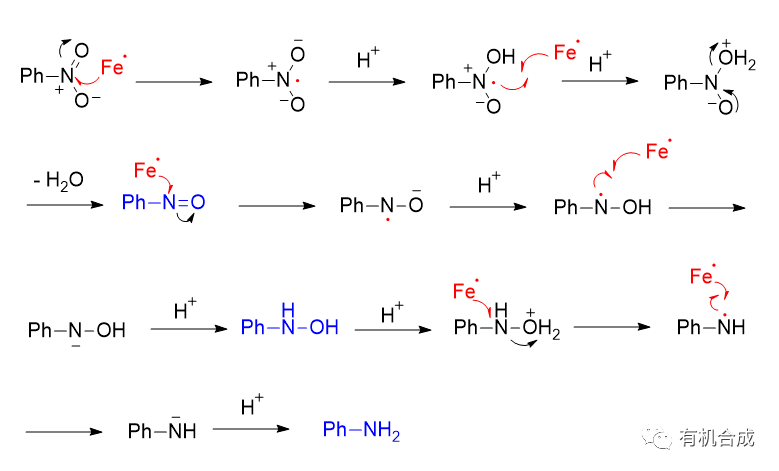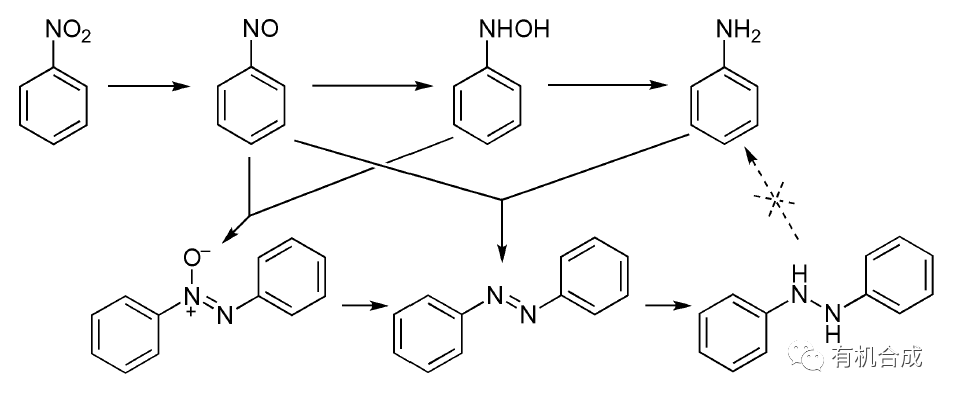| 铁粉还原硝基制备胺是什么机理?铁粉被氧化后生成了啥? | 您所在的位置:网站首页 › 还原反应的机理 › 铁粉还原硝基制备胺是什么机理?铁粉被氧化后生成了啥? |
铁粉还原硝基制备胺是什么机理?铁粉被氧化后生成了啥?
|
原标题:铁粉还原硝基制备胺是什么机理?铁粉被氧化后生成了啥? 1854年,Bechamp首先报道了利用铁粉还原芳香硝基化合物合成芳香伯胺反应,此反应被称为 Bechamp还原反应 。制备芳胺 一般而言,最干净和简便的还原方法就是通过Pd/C或Raney Ni加氢,但是当分子内存在对加氢敏感的官能团,如:卤素(Cl, Br and I; F 对加氢不敏感),双键,三键,氰基,羰基时,我们不得不采用其他方法, 最为经典的要数铁粉的还原。铁粉还原一般在盐类电解质(如,氯化铵)或烯酸条件下进行,此条件可以将芳香硝基,脂肪硝基,亚硝基和羟胺等基团还原为氨基。铁粉还原芳香硝基化合物时,芳基上有吸电子基团时,有利于硝基获得电子,反应容易进行。 常用的还原条件是:一、铁粉/HCl,THF体系或乙醇体系;二、铁粉/AcOH; 另外常用的条件还有,铁粉(5eq),氯化铵(10eq),在甲醇和水混合溶液(4:1)中回流,但此条件很容易形成偶氮化合物,致使反应变黑,氮气保护可以减少偶氮化合物的生成,上述两种酸性条件很少生成偶氮类副产物。 此类反应的后处理,一般情况下都是趁热过滤,防止冷却后,产品吸附到剩余的铁粉和氧化铁上。 强磁力搅拌投反应时,一定要其他原料都加入反应体系中后,最后在剧烈搅拌下慢慢加入铁粉,如果开始就加入铁粉,很可能会搅不动(机械搅拌可以忽略此步骤)。另外可以利用亚铁盐进行还原,可以有效避免搅拌问题。 另外由于铁粉反应后氧化物的颜色较深,不好纯化,有时会用锌粉代替铁粉进行反应,条件类似,锌粉的另外一个优点是利用磁力搅拌器就可以进行较大量的反应。 反应机理 铁粉还原为单电子转移机理,反应中需要转移六个电子,理论上还原硝基至少需要3倍当量铁粉,实际反应操作中一般加入4倍当量以上铁粉。
铁盐比较两个常见的价态是+2价和+3价,反应后铁粉副产物是啥,小编认为这和反应中加入的铁的当量数有关。如果铁粉过量很多,那主要副产物铁盐应该是二价铁,小编做反应时发现铁粉过量时,反应体系如果隔绝空气,体系是白色的,迅速趁热过滤后,滤饼白色的盐迅速变为褐色,这应该是二价铁盐被空气中氧气氧化为三价铁的现象。由于此反应也可以利用二价铁盐做为还原剂,因此反应中肯定是生成三价铁盐。如果铁粉的当量数较低时,考虑到非均相反应,会导致铁粉当量数不足,二价铁盐会继续参与反应生成三价铁盐,那最后铁粉的副产物应该是二价铁盐和三价铁盐的混合物(当然三价铁也会和铁粉反应生成二价铁)。 利用Fe/HCl,进行此反应时,小伙伴肯定有这种疑惑,铁不是会和盐酸反应生成氢气和FeCl2吗?小编认为可能最后主要其还原作用的恰恰是二价铁,因此此体系小编建议铁粉的当量数要稍微大点。 展开全文如上图机理中,反应体系中除了产物还有亚硝基,然后芳香亚硝基化合物和羟胺,亚硝基化合物会和产物氨基生成偶氮化合物,羟胺和亚硝基化合物也反应生成偶氮氧化物,这些偶氮化合物根据结构可能会呈现橙色、红色、深红色乃至红褐色,再加上一些其他杂质,很容易呈现偏黑色。
反应实例 To 300 mL EtOH was added 9.27 g 6-chloro-3-nitro-2-pyrrolopyridine (41 mmol), followed by 115.25 g FeSO4·7H2O(414 mmol), 0.5mL10NHCl, and 5mLwater. The mixture was heated at 80◦C for 90 min, while a 30% ammonia solution was added in little fractions to maintain a basic pH. After cooling, EtOHwas evaporated under vacuum. The residuewas poured in 100 mL water and extracted with Et2O. After the usual treatment, the first amount of the product was obtained. The aqueous phase was alkalinized with ammonia solution and extracted with EtOAc. Finally, 4.59 g 3-amino-6-chloro-2-pyrrolopyridine was obtained as a beige powder, in a yield of 57%, m.p. 89◦C (recrystallization from 80% Et2O and 20%n-hexane). 【 J. Med. Chem. , 1997, 40, 1808】 To mixture of 1.2 g iron (21.6 mmol), 0.25 mL 10 N HCl, 10 mL acetic acid, 10 mL ethanol and 5 mL water was added 1.0 g 2-nitro-5-(2-piperidin-1-ylethoxy)benzaldehyde (3.6 mmol). The mixture was refluxed for 15 min with stirring, and iron was removed by filtration. The product was worked up as usual. 【 J. Med. Chem. , 2002, 45, 5809】 To the starting material (3.1 g) was added acetic acid (24.4 mL) and then, reduced iron powder (9.15 g), and the mixture was stirred for 16 hours at room temperature. The mixture was filtered with Celite, and washed with ethyl acetate. The solvent was removed under reduced pressure, and water was added to the obtained residue, and the mixture was extracted with ethyl acetate. The organic layer was washed with saturated brine, and dried over magnesium sulfate. The solvent was removed under reduced pressure, and the obtained residue was purified by silica gel column chromatography, to give 1.4 g of the desired product. To 80 percent ethanol (5.0 mL), the starting material (300 mg, 1.76 mmol) and concentrated hydrochloric acid (0.45 ml, 5.28 mmol) were added to stir for 10 minutes at 20°C. Then, iron powder (500 mg, 8.95 mmol) was added to the mixture to further stirring for 1 hour at 20°C. Insoluble matters were filtered off and the filtrate was concentrated, adding 0.5N NaOH (10 mL) to the residue, filtering the solution to further remove insoluble matters, extracting the filtrate with chloroform, drying the extract over anhydrous sodium sulfate, concentrating the extract, and distilling the resulting crude product to afford 224 mg of the desired compound (91% yield). 参考资料 一、Comprehensive Organic Name Reactions and Reagents, by Zerong Wang,284-287. 二、药明康德经典化学合成反应标准操作。 返回搜狐,查看更多 责任编辑: |
【本文地址】

